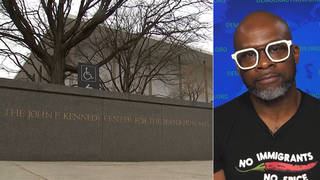
Topics
Guests
- Janis Karpinskiformer brigadier general and author of One Woman’s Army: The Commanding General of Abu Ghraib Tells Her Story.
A group of lawyers filed a lawsuit today calling on German prosecutors to investigate outgoing Defense Secretary Donald Rumsfeld for allegedly sanctioning torture. We go to Berlin to speak with former Brigadier General Janis Karpinski, who served as the commanding officer at Abu Ghraib. She is the highest-ranking U.S. military officer reprimanded over the Abu Ghraib prisoner abuse scandal. [includes rush transcript]
Transcript
AMY GOODMAN: Our next guest in Berlin today is former Brigadier General Janis Karpinski. She was the commander of the three large U.S.- and British-led prisons in Iraq in 2003. She oversaw all military police in Iraq and was the first female ever to command soldiers in a combat zone. In May 2005, she was demoted from brigadier general to colonel over the Abu Ghraib prisoner abuse scandal. She remains the highest-ranking military officer reprimanded for the abuse. Wolfgang Kaleck, the German lawyer leading the litigation, said Karpinski would be the, quote, “star witness” of the case. She’s the author of the book, One Woman’s Army: The Commanding General of Abu Ghraib Tells Her Story. Welcome to Democracy Now!, Janis Karpinski. Tell us why you’re in Berlin today.
JANIS KARPINSKI: Thank you. Good morning, Amy. I’m in Berlin because I was invited to make my presentation. Over the course of time, as you’re probably well aware, we had different discussions. I was first asked for information about what I saw, what I witnessed in Iraq, and what I believe led to what we saw in those photographs. And the case was initially presented and then dismissed.
But again, over the course of time, and opening discussions, Mr. Kaleck decided to proceed and to pursue presenting the case again. I was at a presentation in the United States, and I had the opportunity to meet with them to again clarify some points. And when they asked me if I would be interested in coming here to give a presentation in person, I said it would be a privilege, because it’s the truth. And presenting the truth and presenting first-hand information has become increasingly important in this entire process.
AMY GOODMAN: Can you tell us how it happened? When you were in Iraq, when you were in charge at Abu Ghraib, tell us how you learned about the torture that was taking place, and your jurisdiction, your authority over the area in the prison where these prisoners were tortured.
JANIS KARPINSKI: Well, I think it’s a critical point and certainly important in the discussion, because I was responsible for 17 prison facilities in Iraq, and they were spread all over Iraq. And they were in various stages of disrepair. And our purpose was to assist the prisons experts under the Coalition Provisional Authority with the rebuilding of these and reopening of these prisons. We never wanted to use, and we never planned to use Abu Ghraib for any long-term detention operation, because it was, number one, in one of the most dangerous locations in all of Iraq, in the middle of the Sunni Triangle, and it had a notorious history of abuse and torture under Saddam Hussein. So we were moving in the direction of transferring all of the Iraqi criminals being held at Abu Ghraib to other facilities, as they became open and operational. And our Iraqi criminal population was very limited at Abu Ghraib. Again, we were moving towards closing it completely.
And then, they—the Coalition Provisional—excuse me, the CJTF-7, the coalition forces, undertook these raids and roundups, as they would come to be called, in the different sectors, so that the combat divisions would put together plans to go out and apprehend targeted individuals. But with very little description of the individuals they were attempting to capture and apprehend, very often these operations would take place in a location where there would be 20, 30, 50, 100 people meeting for some reason. And when the operational force arrived there, they would see that there were, not two or three individuals, but 50 or more, so they would arrest everybody. And they started to turn these new security detainees over to Abu Ghraib, contrary to what our plans were of closing it completely. Now we have an enormous growing population.
But in November of 2003, the prison responsibility for Abu Ghraib was transferred from the military police control, my control, to the military intelligence control, making it an interrogation center for all of Iraq, as General Miller planned and directed during his visit in September of 2003. So, I had 16 other prison facilities to be concerned with and to focus on. In fact, in January of 2004, when I first heard about this ongoing investigation at Abu Ghraib, I couldn’t find out from anybody any information or any details of what this investigation really encompassed.
And it wasn’t until the 23rd of January, when I saw the pictures for the first time. And I asked—when I saw the pictures, I asked the commander of the Criminal Investigation Division, “Where is the military intelligence in all of this?” And seeing one of the contract people in some of the photographs, I said, “Why are the translators in any of these photographs?” And I was told, “Ma’am, those aren’t translators. Those are contract interrogators.” So, it was first time not only seeing the pictures, but the first time I was receiving details of contract interrogators actually working out at Abu Ghraib.
When I tried to go to see some of the soldiers, to get access to some of the soldiers seen in some of those photographs, I was told by the JAG officer representing General Sanchez, those soldiers did not work for me, so I had no right to go and speak to any of them. In fact, they worked for the military intelligence commander. It was a different story in April of 2004, when the photographs were released for the world. But there were specific steps taken to keep me from speaking to the individuals, from having information, and from having any insight in terms of what was going on in interrogation operations.
AMY GOODMAN: Some of these people were yours. They were military police. They were the people that you were in charge of, right?
JANIS KARPINSKI: Correct. I had military police personnel working in every one of the prison facilities all over Iraq. But it is important to know that there were interrogation operations at only one facility: Abu Ghraib. And these abuses, or the photographs, the humiliation seen in those photographs, occurred when the prison was no longer under my control. The commander at Abu Ghraib—
AMY GOODMAN: What was it like when you saw the photographs, Janis Karpinski, when you first—can you explain—what was it?—January 2004—and how did you actually get a hold of them?
JANIS KARPINSKI: Well, I heard about this ongoing investigation—as I said, that was on the 12th of January of 2004—tried to get some information to put, you know—get an idea, a better idea, of what was being investigated. And it wasn’t until the 23rd of January, when I saw the photographs for the first time, and they were presented to me by the commander of the Criminal Investigation Division. He called me, said he had the pictures. Could he meet with me? He met with me that night at my operations center. I saw the photographs for the first time, and I was absolutely shocked. I felt—I just felt as if the walls of that room were closing in on me. I felt sickened by what I saw. I was particularly offended by the expressions on the faces of the military people in those pictures.
When I asked the person showing me these photographs, I said, “Well, where’s the military intelligence in all of this?” And there were some explanations, and he told me that they were still pursuing some of those answers. And he pointed out one picture in particular, where he showed me that there were—you couldn’t see all of the people in the picture, but the angle it was taken, you could see all of the feet in the picture. And there were 32 boots, as he pointed out. So, he said each—you know, the bare feet, we believe, belonged to the prisoners, but the boots belonged to U.S. personnel. And 32 boots means that there’s 16 U.S. people in this photograph, and we haven’t identified all of them yet.
So for—four months later, for the seven so-called bad apples to be identified as the—as totally responsible for designing, implementing, and taking these photographs, I knew it was completely wrong from the beginning. But I was shocked by what I saw in those photographs, as I’m sure people around the world were, when they first saw them in April of 2004.
AMY GOODMAN: Janis Karpinski, can you talk about Donald Rumsfeld, number one in this lawsuit for war crimes, and how you know he knew? What physical evidence did you have or command from him?
JANIS KARPINSKI: Well, Amy, I think it’s—again, it’s another important point largely missed in many discussions. The outrage was not ever over the actions in these photographs. The outrage really seemed to be centered on the existence of photographs, because what the photographs did was lift the curtain on what was actually authorized, ordered, designed and directed by people at much higher levels than mine or anybody else serving in Iraq.
When I heard about the investigation and was at another location outside of Baghdad altogether, we prepared to leave at first light the next day, went directly out to Abu Ghraib, and, of course, all of the people who would normally work in those positions, in Cell Block 1A or 1B, they had been removed from their positions. So the sergeant I had the opportunity to speak to was without much information himself.
He explained that he didn’t ordinarily work in the “hard site,” as they called it. But he—and so I asked him for logs or journals to try to piece information together, and he said everything had been seized. All of the information was confiscated in the course of this investigation. But he pointed to a memorandum, one page, regular standard-size piece of paper, on a column just outside of this administrative office that they were using.
And on the column, it talked—the subject was interrogation techniques. And it was a one-page memorandum. It listed a few interrogation techniques to be used for effective interrogations, whatever the wording was. And it—I mean, there was about a half a dozen of them: prolonged standing, disruption of sleep patterns, playing loud music during—throughout the day and during the evening hours, disruption of meal plans, those kind of things.
But it was signed by the secretary of defense. And there was a handwritten annotation in the margin of that memorandum. And it was written—four words: “Make sure this happens.” And I remember my mind, my eye going to it directly, because it was written in such a manner that it was squared off. It seemed to be very military-oriented. But it was the same handwriting, and it appeared to be the same ink, because this was a copy of the memorandum, as the signature on the memorandum, and that was the secretary of defense, Donald Rumsfeld. It was his signature on the memorandum, and it seemed to be the same ink and handwriting in the margin, saying, “Make sure this happens,” referring to those techniques for interrogation.
I said to the sergeant, “Why is an interrogation memorandum here?” And he said, “Ma’am, I don’t know. We were told that this has to be posted.” So, to me, months later, when the other information started to come out and I was individually accused of allowing this to happen, I knew there was no truth to those accusations, but I did recall the memorandum. Certainly, the secretary of defense signature on the memorandum indicated he had knowledge of what was being allowed in terms of interrogation.
AMY GOODMAN: Janis Karpinski, finally, in this lawsuit, also being sued are General Sanchez and Geoffrey Miller, the general who was in charge of Guantanamo, then sent to Abu Ghraib to, quote, “gitmo-ize” it. If you could very briefly talk about your direct knowledge of their knowledge of these operations.
JANIS KARPINSKI: I don’t have any direct knowledge of these operations, except that I saw their testimony in front of the Senate Armed Services Committee, where they denied any knowledge of the photographs and chose their words specifically to work around admitting to any knowledge of the techniques being used. But General Miller did come to Iraq. He was sent specifically to work, not with the detention operations, he was sent specifically to work with the military intelligence personnel to teach them harsher interrogation techniques, to obtain more actionable intelligence from their efforts.
And in the course of his presentation, his initial briefing, he made the comment about—in response to an interrogator who raised the issue about what could we do immediately to enhance our interrogation efforts, because we think we’re doing what we should be doing. And he said it was his impression that they were treating the prisoners too well. And he said, “You need to treat these prisoners like dogs, because if you treat them any differently, you have effectively lost control of your interrogation.” And he went on to explain that at Guantanamo Bay, the prisoners there earned everything they had, to include a change of color of their prison jumpsuits.
And when I raised my hand and suggested that, you know, it was a different situation in Iraq than what he was facing in Guantanamo Bay—for example, we didn’t even have enough funding to give a prisoner, every prisoner, a jumpsuit, let alone a change of colors of jumpsuit—he dismissed my concerns, by saying his budget was $125 million a year, and he would give as much money as was necessary to the military intelligence commander to make this operation work.
AMY GOODMAN:Janis Karpinski, I want to thank you for joining us. Thank you for being with us, former brigadier general and author of One Woman’s Army: The Commanding General of Abu Ghraib Tells Her Story, speaking to us from Berlin, where she will be the star witness in this criminal case against high U.S. military officials, including outgoing Defense Secretary Donald Rumsfeld.












Media Options